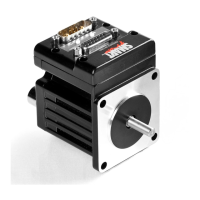Moog Animatics SmartMotor™ Developer's Guide,Rev. L
Page 768 of 909
VA
Velocity Actual
APPLICATION: Motion control
DESCRIPTION: Gets (reads) the actual (filtered) velocity
EXECUTION: Next PIDsample
CONDITIONAL TO: N/A
LIMITATIONS: N/A
REPORT VALUE: RVA
WRITE: Read only
LANGUAGE ACCESS: N/A
UNITS: Scaled encoder counts/sample
RANGE OF VALUES: -2147483648 to 2147483647
TYPICAL VALUES: -3200000 to 3200000
DEFAULT VALUE: 0
FIRMWARE VERSION: 5.x and later
COMBITRONIC: RVA:3, x=VA:3
where ":3" is the motor address — use the actual address or a
variable
DETAILED DESCRIPTION:
The VA command gets (reads) the commanded velocity as follows:
l =VA
Reads the actual velocity measured by the selected encoder. When ENC1 mode is
chosen, the external encoder is used.
The SmartMotor can be given a variety of motion commands. Under all types of motion, the
actual velocity (rotational) can be reported. This also applies to a back-driven motor when the
drive is off.
The value reported is measured from the encoder, so it is based on real-world data rather
than an internal calculation. In order to filter the noise from this data, an infinite impulse
response (IIR) digital filter is applied. An IIR filter is similar to a moving average but includes
all previous data points. The significance of the previous points is diminished while new data
points are added. The coefficient of this filter can be adjusted with the VAC command for a
longer or shorter time constant. There is a trade-off between quick responsiveness and
resolution. The default value for the filter constant should work well for most applications.
Equations for Real-World Units:
Because the encoder resolution and sample rate can vary, the following general equations can
be applied to converting the value of VA to various units of velocity. These equations force
floating-point calculations to avoid overflow and maintain resolution. They can be placed in a
user program, or they can be precalculated if the values of SAMP and RES are known (SAMP
Part 2: Commands: VA

